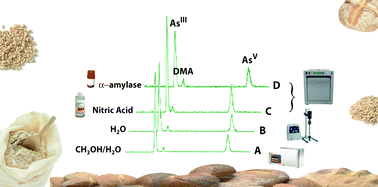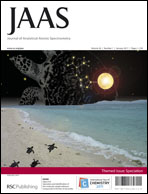Wheat appears to be the major contributor to the intake of inorganic arsenic in countries where the diet is not rice-based. Ultrasound- and microwave-assisted extraction of arsenic in wheat and wheat based food using different solvents or enzymes was investigated in terms of extraction yield and species stability. Four extraction procedures were selected for the study of arsenic speciation in wheat and wheat products by anion exchange HPLC-ICP-MS using a PRP-X100 column with 10 mM NH4H2PO4, 10 mM NH4NO3, and 2% CH3OH at pH 5.5 as the mobile phase. Total arsenic in the samples ranged from 8.6 to 29.8 ng g−1 dry weight. About 95% of the arsenic was found to be present in inorganic form with AsIII as the most abundant species, whereas the remainder was mainly DMA. Microwave-assisted extraction with HNO3 was the most effective in liberating the arsenic species, which were then satisfactorily recovered from the chromatographic column. The LODs achieved, i.e., 0.35–0.46 ng g−1 dry weight, were suitable for the determination of arsenic species at the low levels found in sample extracts.

You have access to this article
 Please wait while we load your content...
Something went wrong. Try again?
Please wait while we load your content...
Something went wrong. Try again?


 Please wait while we load your content...
Please wait while we load your content...